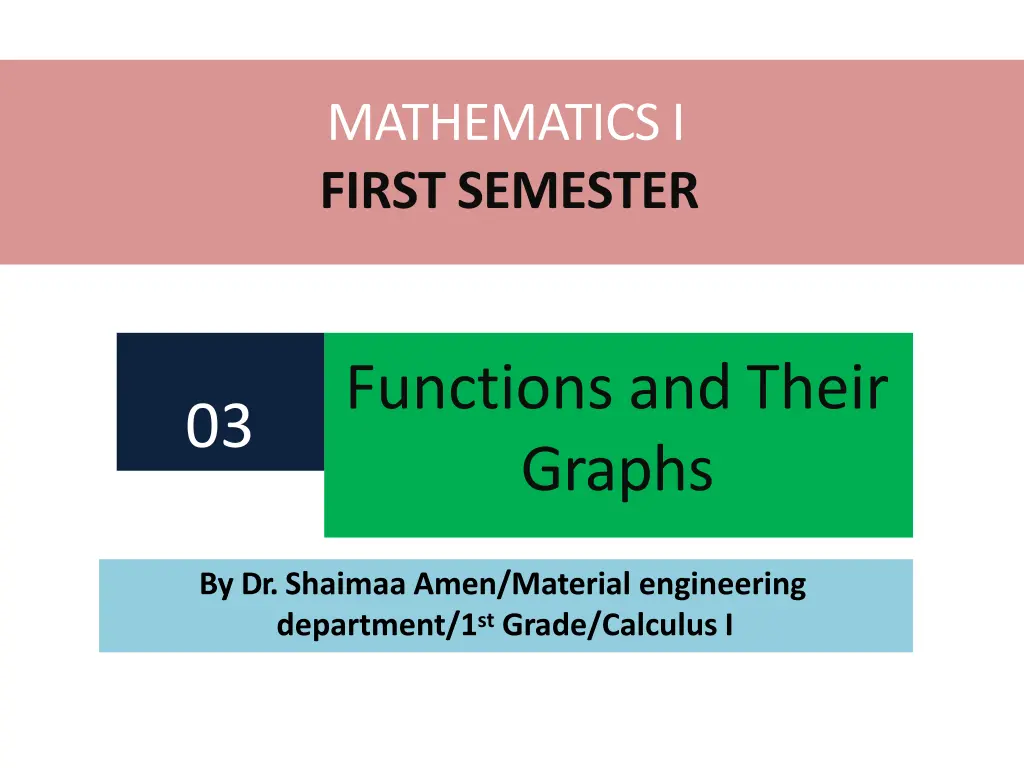
Understanding Functions and Graphs in Mathematics
Learn about functions, domain, range, graphs, and more in Mathematics I first semester. Explore the concept of functions from set D to set Y with unique rules and assignments. Understand domain as the set of possible input values and range as the set of all output values. Dive into solving functions, exercises, and graphing functions for a comprehensive understanding.
Download Presentation

Please find below an Image/Link to download the presentation.
The content on the website is provided AS IS for your information and personal use only. It may not be sold, licensed, or shared on other websites without obtaining consent from the author. If you encounter any issues during the download, it is possible that the publisher has removed the file from their server.
You are allowed to download the files provided on this website for personal or commercial use, subject to the condition that they are used lawfully. All files are the property of their respective owners.
The content on the website is provided AS IS for your information and personal use only. It may not be sold, licensed, or shared on other websites without obtaining consent from the author.
E N D
Presentation Transcript
MATHEMATICS I FIRST SEMESTER Functions and Their Graphs 03 By Dr.Shaimaa Amen/Material engineering department/1stGrade/Calculus I
Outlines Function Domain and Range Graphs of Functions Piecewise-Defined Functions The Greatestand Least IntegerFunctions Typesof functions EvenFunctions and Odd Functions: Symmetry Composite Functions Shifting a Graph of a Function -Vertical Shifts - Horizontal Shifts
Functions Afunction from a set D to a set Y is a rule that assigns a unique (single) element (x) Y to each element x D. Asymbolic way to say y is a function of x is bywriting y = (x) ( y equals ofx ). The symbol represents the function. The letter x, called the independent variable, represents the input value of , and y, the dependent variable, represents the corresponding output value of at x.
Domain and Range Domain: The set from which the value of x can be chosen is called the domain of the function. Range: The set of all values of y is called the range of thefunction.
Graphs of Functions If is a function with domain D, its graph consists of the points in the Cartesian plane whose coordinates are the input-output pairs for . Inset notation, the graph is {( x , (x)) | x D}. Tograph the function we need, 1. Make a table of xy-pairs thatsatisfy the function rule. 2. Plot the points (x, y). 3.Draw a smooth curve through the plotted points. Label thecurve with its equation. Example 2: Sketching a Graph 1. Graph the function (x) = x + 2 Solution: The graph of the function (x) = x + 2 is the set of points with coordinates (x, y) forwhich y = x + 2. Its graph is sketched inFigure.
The Greatest and Least Integer Functions The function whose value at any number x is the greatest integerless thanorequal to x is called the greatest integer function, It is denoted, [x] or [[x]] or int x. Figure shows the graph. [2.4] = 2 , [ 1.9 ] = 1 , [ 0 ] = 0 , [ 2 ] = 2, [ 0.2 ] = 0 The function whose value at any number x is the smallest integer greaterthanorequal to x is called the least integerfunction , [ -2 ] = - 2, [ - 1.2 ] = -2, [ - 0,3 ] = - 1 .
MATHEMATICSI FIRSTSEMESTER Functions and Their Graphs 04 By Dr.Shaimaa Amen/Material engineering department/1stGrade/Calculus I
Types of functions 1. LinearFunctions:Afunctionof the form f(x) =mx +b for constantsm and b, is called a linear function. Figure shows an array of lines f(x) =mx where b = 0, so these lines pass through theorigin. AConstant functions has slope m = 0, Figureshows.
5. Algebraic Functions: An algebraic function is a function constructed from polynomials using algebraic operations (addition, subtraction, multiplication, division, and taking roots). Rational functions are special cases of algebraic functions. Figure displays the graphsof three algebraic functions. 6. TrigonometricFunctions:Thegraphstrigonometricfunctionsof the sine and cosinefunctions are shownin Figure.
EvenFunctions and Odd Functions: Symmetry Afunction y = (x) isan even function of x if (-x) = (x), odd function of x if (-x) = - (x), for every x in the function sdomain. Afunction f is even if and only if the graph off is symmetric about they-axis. The graph of an odd function is symmetric about theorigin.
